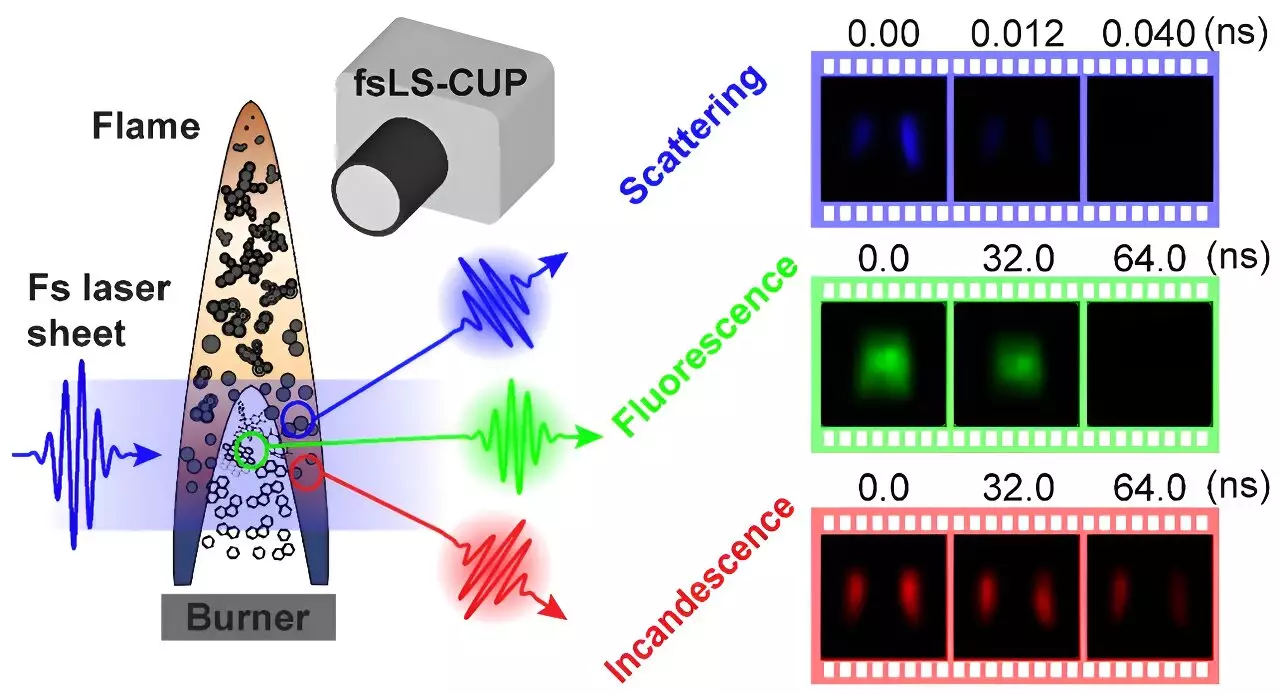In the realms of combustion science and astrophysics, the small but potent soot particles and polycyclic aromatic hydrocarbons (PAHs) pose significant challenges. These tiny carbon-based particles result from the incomplete combustion processes in everyday scenarios, such as candle flames and aircraft engines, emitting harmful compounds detrimental to both human health and the environment. Surprisingly, PAHs are not only vital in terrestrial contexts but also represent a substantial portion—10-12%—of interstellar matter. The intricate relationship between these particles and their environments highlights the urgency for a deeper understanding of their dynamics, especially given their promise in advancing electronic devices and sustainable energy solutions.
However, capturing the fleeting story of soot and PAHs is no easy feat. Their existence in flames is measured in billionths of a second, necessitating cutting-edge imaging technologies capable of capturing rapid events. Present imaging systems struggle, typically reaching only a few million frames per second and often leading to unintended heating effects during the imaging process.
The emergence of a groundbreaking technology, femtosecond laser sheet-compressed ultrafast photography (fsLS-CUP), may finally provide the solution researchers have awaited. A collaborative effort emerging from renowned institutions, including Caltech and Friedrich-Alexander University, has introduced this innovative imaging system. Characterized as the world’s fastest single-shot planar imaging camera, fsLS-CUP dramatically escalates temporal resolution, achieving astonishing speeds of 250 billion frames per second. This advancement marks a staggering 20,000-fold increase over previous imaging methods, offering scientists the ability to witness and analyze some of the fastest natural phenomena on a grand scale.
Dr. Yogeshwar Nath Mishra and his team designed fsLS-CUP to function with a single femtosecond laser pulse, setting aside the multiple laser pulses traditionally used. This capability allows for wide-field, real-time imaging while simultaneously monitoring laser-induced fluorescence from PAHs, as well as laser-induced heating effects from soot. The ability to capture transient occurrences effectively compiles the fleeting data into coherent visuals, providing unprecedented insights into combustion dynamics.
The implications of this technology reach far beyond mere combustion research. By advancing the understanding of PAH and soot formation, scientists can glean broader insights regarding the conditions that foster life and cosmic evolution—a mission that aligns with ongoing investigations at NASA. The versatility of fsLS-CUP allows for applications across multiple disciplines, including physics, chemistry, biology, and medicine. The technique does not merely improve our grasp of combustion phenomena; it potentially revolutionizes how transient events are studied in real-time, opening avenues for new discoveries.
Additionally, Dr. Peng Wang articulated the potential of this technology to transform fundamental science and engineering. By augmenting the speed, spatial resolution, and fidelity of imaging, scientists can better capture rapid responses and dynamics that were once confined to theoretical models or slow-motion sequences. This level of detail supports clearer data interpretation, fostering enhanced future research that can bridge gaps across various scientific fields.
One notable area in which this innovative technology can illuminate our comprehension is astrochemistry, particularly concerning PAHs. Dr. Murthy S. Gudipati emphasizes the importance of understanding PAH formation under unique astrophysical conditions, which could provide insights into the development of these compounds in environments like carbon-rich asymptotic giant branch stars. With the ability to observe and analyze the behaviors of these molecules under rapid chemical changes, researchers can unravel their life cycles and patterns across the cosmos.
Moreover, the technology’s ability to depict the fluorescent lifetimes of PAHs as well as interactions within soot points towards larger implications in environmental studies. By capturing the transient effects of these compounds, fsLS-CUP can aid in developing methods to mitigate their harmful effects on both health and the environment, bridging the gap between academic research and practical application.
The introduction of fsLS-CUP represents a significant milestone in ultrafast imaging, redefining how we observe and understand complex fast phenomena. As this technology gains traction, the profound depth of knowledge about PAHs, soot, and their interactions within different environments will likely expand dramatically. Such advancements have the potential not only to reshape scientific inquiry but also to foster multidisciplinary collaborations that propel growth across numerous fields. With further technological refinements and research applications, we are poised to unlock the mysteries of transient phenomena that govern the universe around us.


Leave a Reply